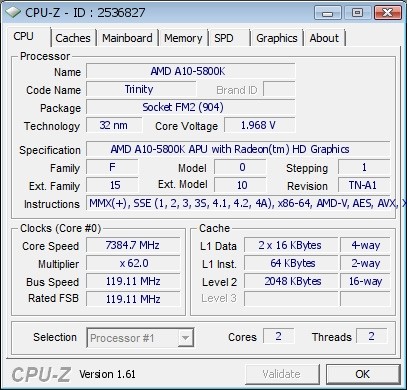MSI sends word today that AMD’s second generation A10-5800K desktop APU has recently been overclocked to record-setting levels. The chip was coaxed to 7.38GHz using an MSI FM2-A85XA-G65 and a custom liquid nitrogen cooling solution. The overclock can be verified using the CPU-Z validation database.
MSI’s press release is light on details but we can gather some more data from the CPU-Z screenshot. Of interest is the fact that 1.968 volts were required to reach 7.38GHz. In our recent review of the A10-5800K, a traditional air cooling solution allowed Steve to push the CPU up to 4.5GHz using 1.5 volts – an 18 percent increase over the stock 3.8GHz base frequency.

We also learn that a multiplier of 62 was used with a bus speed of 119.11MHz to reach their goal. Two 4GB sticks of G.Skill DDR3 memory were used as well, clocked at 794.1MHz with timings of 9-9-9-24.
Astute viewers may have noticed that the high clock speed was reached with only two cores enabled despite the fact that this is a quad-core processor. Disabling extra cores for extreme overclocking purposes is common practice which shouldn’t detract from the accomplishment.
It goes without saying that extreme tests like this aren’t exactly indicative of what the average user can expect to get out of their CPU. Liquid nitrogen certainly isn’t a sustainable cooling method but it is interesting to see what hardware can accomplish when it is super cooled by experts for maximum clock testing like this.